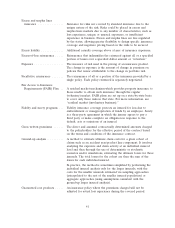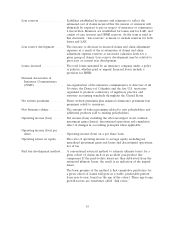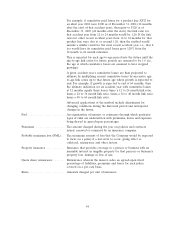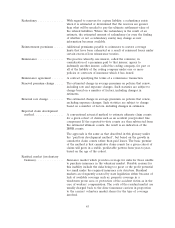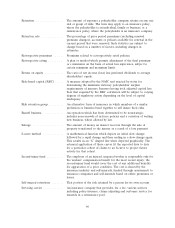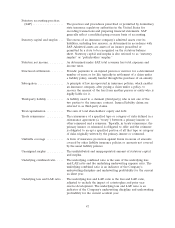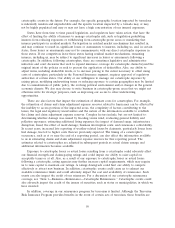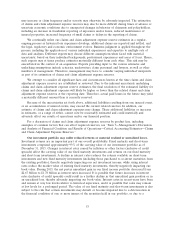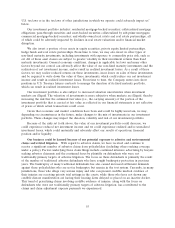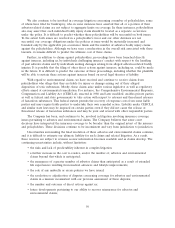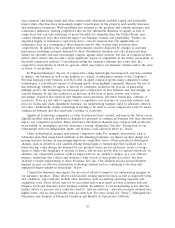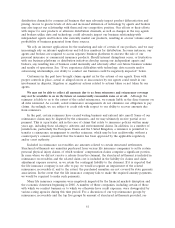Travelers 2015 Annual Report Download - page 51
Download and view the complete annual report
Please find page 51 of the 2015 Travelers annual report below. You can navigate through the pages in the report by either clicking on the pages listed below, or by using the keyword search tool below to find specific information within the annual report.subject to a deductible and other limitations. The program expired at the end of 2014 but was
reauthorized, with some adjustments to its provisions, in January 2015 for six years through
December 31, 2020. Under current provisions of this program, once our losses exceed 20% of our
commercial property and casualty insurance premium for the preceding calendar year, the federal
government will reimburse us for 84% of our losses attributable to certain acts of terrorism which
exceed this deductible up to a total industry program cap of $100 billion. Our estimated deductible
under the program is $2.43 billion for 2016. Over the remaining five-year life of the reauthorized
program, the federal government reimbursement percentage will fall from 84% to 80%. In addition,
because the interpretation of this law is untested, there is substantial uncertainty as to how it will be
applied to specific circumstances. For example, application of the law to a specific event will depend
upon whether the government has designated such event as a covered event. It is also possible that
future legislation could change or eliminate the program, which could adversely affect our business by
increasing our exposure to terrorism losses, or by lowering our business volume through efforts to avoid
that exposure. For a further description of the Terrorism Risk Insurance Program, see note 5 of notes
to the consolidated financial statements herein.
Because of the risks set forth above, catastrophes such as those caused by various natural events or
man-made events such as a terrorist attack or other intentionally destructive acts, including those
involving nuclear, biological, chemical, radiological or cyber events, could materially and adversely
affect our results of operations, financial position and/or liquidity. Further, we may not have sufficient
resources to respond to claims arising from a high frequency of high severity natural catastrophes
and/or of man-made catastrophic events involving conventional means. In addition, while we seek to
manage our exposure to man-made catastrophic events involving conventional means, we may not have
sufficient resources to respond to claims arising out of one or more man-made catastrophic events
involving ‘‘unconventional’’ means, such as nuclear, biological, chemical or radiological events.
During or following a period of financial market disruption or economic downturn, our business
could be materially and adversely affected. Worldwide financial markets have, from time to time,
experienced significant disruption. For example, during the financial crisis that started approximately
eight years ago, the United States and many other economies experienced a prolonged economic
downturn, resulting in heightened credit risk, reduced valuation of certain investments and decreased
economic activity. Financial markets may again experience significant and prolonged disruption,
including as a result of unanticipated events. In the years following the financial crisis, the federal
government, particularly the Federal Reserve, has taken extraordinary steps to stabilize financial
markets, encourage economic growth and keep interest rates low. During this time, the United States
has experienced a slow rate of economic growth. Even if economic growth continues in the United
States, or other regions in which we do business, it may be at a slow or slower rate for an extended
period of time. While inflation has recently been limited and that trend may continue, it is possible that
the steps taken by the federal government to stabilize financial markets and improve economic
conditions could lead to an inflationary environment. Further, such steps may be ineffective and, in the
case of the Federal Reserve, actual or anticipated efforts to continue to unwind some of such steps
could disrupt financial markets and/or could adversely impact the value of our investment portfolio or
general economic conditions.
Financial market disruption or economic downturns could be exacerbated by actual or potential
economic and geopolitical instability in many regions of the world. This can impact our business even if
we do not conduct business in the region subject to the instability. For example, due to globalization,
instability in one region can spread to other regions where we do business. In Europe, uncertainty in
recent years has included the increased potential for default by one or more European sovereign debt
issuers, the potential partial or complete dissolution of the Eurozone and its common currency and the
negative impact of such potential events on global financial institutions and capital markets generally.
Actions or inactions of European governments may impact these actual or perceived risks. In the
51


